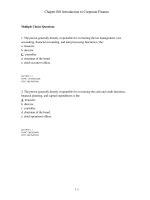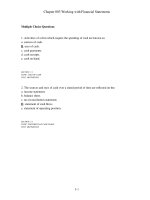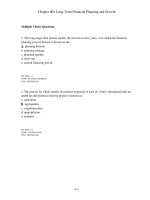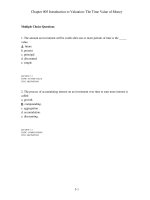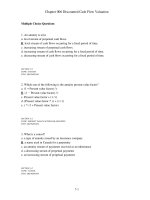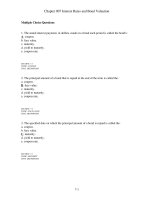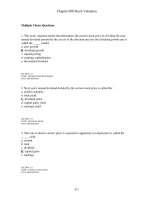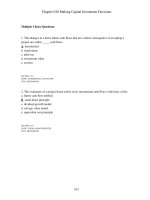Test bank corporate finance 8e ros chap011
Bạn đang xem bản rút gọn của tài liệu. Xem và tải ngay bản đầy đủ của tài liệu tại đây (376.39 KB, 40 trang )
Chapter 011 Project Analysis and Evaluation
Multiple Choice Questions
1. Forecasting risk is defined as the:
a. possibility that some proposed projects will be rejected.
b. process of estimating future cash flows relative to a project.
C. possibility that errors in projected cash flows will lead to incorrect decisions.
d. process of ascertaining the incremental cash flows for a project.
e. possibility that tax rates could change over the life of a project.
SECTION: 11.1
TOPIC: FORECASTING RISK
TYPE: DEFINITIONS
2. Scenario analysis is defined as:
a. the determination of the most likely outcome for a project.
B. analyzing the changes in NPV estimates when whatif questions are posed.
c. isolating the effect that one variable has on the NPV of a project.
d. comparing the NPV of a project both with and without considering the effects of erosion.
e. determining the acceptability of a project based solely on the project's operating cash flows.
SECTION: 11.2
TOPIC: SCENARIO ANALYSIS
TYPE: DEFINITIONS
3. An analysis of what happens to the estimate of net present value when only one variable is
changed is called _____ analysis.
a. forecasting
b. scenario
C. sensitivity
d. simulation
e. breakeven
SECTION: 11.2
TOPIC: SENSITIVITY ANALYSIS
TYPE: DEFINITIONS
11-1
Chapter 011 Project Analysis and Evaluation
4. An analysis which combines scenario analysis with sensitivity analysis is called _____
analysis.
a. forecasting
b. scenario
c. sensitivity
D. simulation
e. breakeven
SECTION: 11.2
TOPIC: SIMULATION ANALYSIS
TYPE: DEFINITIONS
5. Variable costs:
A. change in direct relationship to the quantity of output produced.
b. are constant in the shortrun regardless of the quantity of output produced.
c. reflect the change in NPV when one more unit of output is produced and sold.
d. are subtracted from fixed costs to compute the contribution margin.
e. are inversely related to the number of units sold.
SECTION: 11.3
TOPIC: VARIABLE COSTS
TYPE: DEFINITIONS
6. Fixed costs:
a. change as the quantity of output produced changes.
B. are constant over the shortrun regardless of the quantity of output produced.
c. reflect the change in a variable when one more unit of output is produced.
d. are subtracted from sales to compute the contribution margin.
e. can be ignored in scenario analysis since they are constant over the life of a project.
SECTION: 11.3
TOPIC: FIXED COSTS
TYPE: DEFINITIONS
11-2
Chapter 011 Project Analysis and Evaluation
7. The change in revenue that occurs when one more unit of output is sold is called the _____
revenue.
A. marginal
b. average
c. total
d. fixed
e. variable
SECTION: 11.3
TOPIC: MARGINAL REVENUE
TYPE: DEFINITIONS
8. The sales level that results in a project's net income exactly equaling zero is called the
_____ breakeven.
a. operational
b. leveraged
C. accounting
d. cash
e. financial
SECTION: 11.3
TOPIC: ACCOUNTING BREAKEVEN
TYPE: DEFINITIONS
9. The sales level that results in a project's operating cash flow exactly equaling zero is called
the _____ breakeven.
a. operational
b. leveraged
c. accounting
D. cash
e. financial
SECTION: 11.4
TOPIC: CASH BREAKEVEN
TYPE: DEFINITIONS
11-3
Chapter 011 Project Analysis and Evaluation
10. The sales level that results in a project's net present value exactly equaling zero is called
the _____ breakeven.
a. operational
b. leveraged
c. accounting
d. cash
E. financial
SECTION: 11.4
TOPIC: FINANCIAL BREAKEVEN
TYPE: DEFINITIONS
11. Operating leverage is the:
a. dependence of a firm on variable costs.
b. percentage of a sales price that is needed to cover variable costs.
c. percentage of the sales price which represents the contribution margin.
D. degree to which a firm relies on fixed costs.
e. amount of debt used to finance a project.
SECTION: 11.5
TOPIC: OPERATING LEVERAGE
TYPE: DEFINITIONS
12. The percentage change in operating cash flow relative to the percentage change in
quantity sold is called the:
a. marginal profit.
B. degree of operating leverage.
c. gross profit.
d. net profit.
e. contribution margin.
SECTION: 11.5
TOPIC: DEGREE OF OPERATING LEVERAGE
TYPE: DEFINITIONS
11-4
Chapter 011 Project Analysis and Evaluation
13. The procedure of allocating a fixed amount of funds for capital spending to each business
unit is called:
a. marginal spending.
b. average spending.
C. soft rationing.
d. hard rationing.
e. marginal rationing.
SECTION: 11.6
TOPIC: SOFT RATIONING
TYPE: DEFINITIONS
14. Hard rationing is defined as the situation where:
a. two projects have the same NPV but only one project can be financed.
b. firms are forced to chose one project over another.
c. divisions within a firm are granted equal amounts for capital expenditures.
d. divisions within a firm request more funds for capital projects than firms have available for
use.
E. a firm is unable to raise the funds needed for a project from any source.
SECTION: 11.6
TOPIC: HARD RATIONING
TYPE: DEFINITIONS
15. Forecasting risk emphasizes the point that the correctness of any decision to accept or
reject a project is highly dependent upon the:
a. method of analysis used to make the decision.
b. initial cash outflow.
c. ability to recoup any investment in net working capital.
D. accuracy of the projected cash flows.
e. length of the project.
SECTION: 11.1
TOPIC: FORECASTING RISK
TYPE: CONCEPTS
11-5
Chapter 011 Project Analysis and Evaluation
16. Jennie is fairly cautious when considering new opportunities and therefore analyzes each
project to determine the most optimistic, the most realistic, and the most pessimistic outcome
that can reasonably be expected. Jennie is using:
a. forecast modeling.
b. sensitivity analysis.
c. breakeven analysis.
d. soft rationing.
E. scenario analysis.
SECTION: 11.2
TOPIC: SCENARIO ANALYSIS
TYPE: CONCEPTS
17. Conducting scenario analysis on a proposed project helps managers determine the:
a. impact that an individual variable has on the outcome of the project.
b. initial cost that will be required to implement the project.
c. actual profitable life of the project.
d. level of funding available for the project.
E. potential range of reasonable outcomes that might be realized.
SECTION: 11.2
TOPIC: SCENARIO ANALYSIS
TYPE: CONCEPTS
18. When conducting a best case scenario analysis, you should assume that:
a. the number of units sold and the variable cost per unit are at the high end of their potential
ranges.
B. the salvage value will be at the high end of its possible range.
c. sales quantity will be at the low end of its range while the sales price is the highest price
possible.
d. the variable costs per unit are at the high end of potential cost range.
e. fixed costs will become variable and decrease in dollar amount.
SECTION: 11.2
TOPIC: SCENARIO ANALYSIS
TYPE: CONCEPTS
11-6
Chapter 011 Project Analysis and Evaluation
19. The base case values used in scenario analysis are the ones considered the most:
a. optimistic.
b. desired by management.
c. pessimistic.
d. conducive to creating a positive net present value.
E. likely to occur.
SECTION: 11.2
TOPIC: SCENARIO ANALYSIS
TYPE: CONCEPTS
20. Which of the following variables will be at their highest expected level under a worst case
scenario?
I. fixed cost
II. sales price
III. variable cost
IV. sales quantity
a. I only
b. III only
c. II and III only
D. I and III only
e. I, III, and IV only
SECTION: 11.2
TOPIC: SCENARIO ANALYSIS
TYPE: CONCEPTS
21. When you assign the highest sales price and the lowest costs to a project, you are
analyzing the project under the condition known as:
a. optimistic sensitivity.
b. pessimistic sensitivity.
C. optimistic scenario analysis.
d. pessimistic scenario analysis.
e. base case scenario analysis.
SECTION: 11.2
TOPIC: SCENARIO ANALYSIS
TYPE: CONCEPTS
11-7
Chapter 011 Project Analysis and Evaluation
22. Which one of the following statements concerning scenario analysis is correct?
a. The worst case scenario determines the maximum loss, in current dollars, that a firm could
incur from a given project.
b. Scenario analysis reflects the entire range of results that can be realized from a proposed
investment project.
c. Scenario analysis provides a clear signal to management to either accept or reject a
proposed project.
D. Scenario analysis provides management with a glimpse of the possible range of outcomes
that could be realized from a project.
e. When the base case scenario results in a positive net present value, management can be
assured the proposed project will meet or exceed their expectations.
SECTION: 11.2
TOPIC: SCENARIO ANALYSIS
TYPE: CONCEPTS
23. Sensitivity analysis determines the:
a. range of possible outcomes given that most variables can assume a range of values.
B. degree to which the net present value reacts to changes in a single variable.
c. extent of the range of net present values that can be realized from a proposed project.
d. degree to which a project is reliant upon the fixed costs.
e. ideal ratio of variable costs to fixed costs for profit maximization.
SECTION: 11.2
TOPIC: SENSITIVITY ANALYSIS
TYPE: CONCEPTS
24. Assume you graph the changes in net present value against the changes in the value of a
single variable used in a project. The steepness of the resulting function illustrates the:
a. degree of operating leverage within the project.
b. tradeoff of variable versus fixed costs utilized by the project.
c. range of total outcomes possible from accepting a proposed project.
d. contribution margin of the project at various levels of output.
E. degree of sensitivity of the project's outcome to changes in the single variable.
SECTION: 11.2
TOPIC: SENSITIVITY ANALYSIS
TYPE: CONCEPTS
11-8
Chapter 011 Project Analysis and Evaluation
25. As the degree of sensitivity of a project to a single variable rises, the:
a. less important the variable to the final outcome of the project.
b. less volatile the project's net present value to that variable.
C. greater the importance of accurately predicting the value of that variable.
d. greater the profit margin of the project.
e. less volatile the project's outcome.
SECTION: 11.2
TOPIC: SENSITIVITY ANALYSIS
TYPE: CONCEPTS
26. Sensitivity analysis is based on:
A. varying a single variable and measuring the resulting change in the NPV of a project.
b. applying differing discount rates to a project's cash flows and measuring the effect on the
NPV.
c. expanding and contracting the number of years for a project to determine the optimal
project length.
d. the best, worst, and most expected situations.
e. various states of the economy and the probability of each state occurring.
SECTION: 11.2
TOPIC: SENSITIVITY ANALYSIS
TYPE: CONCEPTS
27. To ascertain whether the accuracy of a variable cost estimate for a project will have much
effect on the final outcome of that project, you should conduct _____ analysis.
a. leverage
b. scenario
c. breakeven
D. sensitivity
e. cash flow
SECTION: 11.2
TOPIC: SENSITIVITY ANALYSIS
TYPE: CONCEPTS
11-9
Chapter 011 Project Analysis and Evaluation
28. Simulation analysis is based on assigning a _____ and analyzing the results.
a. narrow range of values to a single variable
b. narrow range of values to multiple variables simultaneously
c. wide range of values to a single variable
D. wide range of values to multiple variables simultaneously
e. single value to each of the variables
SECTION: 11.2
TOPIC: SIMULATION
TYPE: CONCEPTS
29. The type of analysis that is most dependent upon the use of a computer is _____ analysis.
a. scenario
b. breakeven
c. sensitivity
d. degree of operating leverage
E. simulation
SECTION: 11.2
TOPIC: SIMULATION
TYPE: CONCEPTS
30. Which one of the following is most likely a fixed cost?
A. office rent
b. employee wages
c. sales tax
d. raw materials
e. shipping costs
SECTION: 11.3
TOPIC: FIXED COSTS
TYPE: CONCEPTS
11-10
Chapter 011 Project Analysis and Evaluation
31. Which one of the following statements concerning variable costs is correct?
a. Variable costs minus fixed costs equal marginal costs.
b. Variable costs are equal to fixed costs when production is equal to zero.
c. An increase in variable costs increases the operating cash flow.
d. Variable costs are inversely related to fixed costs.
E. Variable costs are inversely related to operating cash flow.
SECTION: 11.3
TOPIC: VARIABLE COSTS
TYPE: CONCEPTS
32. As the variable cost per unit increases, the:
A. contribution margin decreases.
b. number of units sold decreases.
c. fixed cost per unit decreases.
d. operating cash flow increases.
e. net profit increases.
SECTION: 11.3
TOPIC: VARIABLE COSTS
TYPE: CONCEPTS
33. As additional fixed assets are purchased for a project, the project's level of fixed costs
_____ and the degree of operating leverage _____.
A. increases; increases
b. increases; decreases
c. decreases; increases
d. decreases; decreases
e. remains constant; remains constant
SECTION: 11.3
TOPIC: FIXED COSTS
TYPE: CONCEPTS
11-11
Chapter 011 Project Analysis and Evaluation
34. Which one of the following is a fixed cost in the shortrun?
a. packaging and shipping costs
b. wages for a machine operator
c. the cost of raw materials
d. the cost of water used in the production process
E. threeyear lease on a delivery truck
SECTION: 11.3
TOPIC: FIXED COSTS
TYPE: CONCEPTS
35. Management wants to offer a "Thank You" sale to its customers by offering to sell
additional units of a product at the lowest price possible without affecting the firm's profits.
The price management charges for these onetime sale units should be set equal to the:
a. average variable cost.
b. average total cost.
c. average total revenue.
d. marginal revenue.
E. marginal cost.
SECTION: 11.3
TOPIC: MARGINAL COST
TYPE: CONCEPTS
11-12
Chapter 011 Project Analysis and Evaluation
36. The president of your firm would like to offer special sale prices to your best customers
under the following terms:
The prices will apply only to units purchased in excess of those normally purchased by the
customer.
The units purchased must be paid for in cash at the time of sale.
The total quantity sold under these terms cannot exceed the excess capacity of the firm.
The net profit of the firm should not be affected either positively or negatively.
Given these conditions, the special sale price should be set equal to the:
a. average variable cost.
b. average total cost minus the marginal cost.
c. sensitivity value of the variable cost.
D. marginal cost.
e. marginal cost minus the average fixed cost per unit.
SECTION: 11.3
TOPIC: MARGINAL COST
TYPE: CONCEPTS
37. The contribution margin per unit is equal to the:
a. sales price per unit minus the total costs per unit.
b. variable cost per unit minus the fixed cost per unit.
C. sales price per unit minus the variable cost per unit.
d. pretax profit per unit divided by the sales price.
e. aftertax profit per unit divided by the sales price.
SECTION: 11.3
TOPIC: CONTRIBUTION MARGIN
TYPE: CONCEPTS
11-13
Chapter 011 Project Analysis and Evaluation
38. At the accounting breakeven point, the contribution margin must equal:
a. total costs.
b. fixed costs.
c. the earnings before interest and taxes.
D. fixed costs plus depreciation.
e. depreciation.
SECTION: 11.3
TOPIC: ACCOUNTING BREAKEVEN
TYPE: CONCEPTS
11-14
Chapter 011 Project Analysis and Evaluation
39. Which of the following statements are correct concerning the accounting breakeven
point?
I. The net income is equal to zero.
II. The net present value is equal to zero.
III. The quantity sold is equal to the total fixed costs plus depreciation divided by the
contribution margin.
IV. The quantity sold is equal to the total fixed costs divided by the contribution margin.
A. I and III only
b. I and IV only
c. II and III only
d. II and IV only
e. I, II, and IV only
SECTION: 11.3
TOPIC: ACCOUNTING BREAKEVEN
TYPE: CONCEPTS
40. At the accounting breakeven level of sales, the operating cash flow is equal to:
a. zero.
B. depreciation.
c. fixed costs plus depreciation.
d. net income plus taxes.
e. the variable costs.
SECTION: 11.3
TOPIC: ACCOUNTING BREAKEVEN
TYPE: CONCEPTS
41. All else constant, the accounting breakeven level of sales will decrease when the:
a. fixed costs increase.
B. depreciation expense decreases.
c. contribution margin decreases.
d. variable costs per unit increase.
e. selling price per unit decreases.
SECTION: 11.3
TOPIC: ACCOUNTING BREAKEVEN
TYPE: CONCEPTS
11-15
Chapter 011 Project Analysis and Evaluation
42. At the accounting breakeven point, the:
a. payback period must equal the required payback period.
b. NPV is zero.
C. IRR is zero.
d. contribution margin equals the fixed costs.
e. contribution margin is zero.
SECTION: 11.3
TOPIC: ACCOUNTING BREAKEVEN
TYPE: CONCEPTS
43. A project has a payback period that exactly equals the project's life. The project is
operating at:
a. its maximum capacity.
b. the financial breakeven point.
c. the cash breakeven point.
D. the accounting breakeven point.
e. a zero level of output.
SECTION: 11.3
TOPIC: ACCOUNTING BREAKEVEN
TYPE: CONCEPTS
44. Roger just completed analyzing a project. His analysis indicates that the project will have
a 5year life and require an initial cash outlay of $225,000. Annual sales are estimated at
$685,000 and the tax rate is 35 percent. The net present value is a negative $225,000. Based
on this analysis, the project is expected to operate at the:
a. maximum possible level of production.
b. minimum possible level of production.
c. financial breakeven point.
d. accounting breakeven point.
E. cash breakeven point.
SECTION: 11.4
TOPIC: CASH BREAKEVEN
TYPE: CONCEPTS
11-16
Chapter 011 Project Analysis and Evaluation
45. A project has a projected IRR of negative 100 percent. Which one of the following
statements must also be true concerning this project?
a. The discounted payback period equals the life of the project.
B. The estimated sales volume is equal to the cash breakeven level of sales.
c. The estimated sales volume is equal to the financial breakeven level of sales.
d. The payback period is exactly equal to the life of the project.
e. The net present value of the project is equal to zero.
SECTION: 11.4
TOPIC: CASH BREAKEVEN
TYPE: CONCEPTS
46. Which of the following are characteristics of a project with sales set at the cash break
even point?
I. The project never pays back.
II. The IRR equals the required rate of return.
III. The NPV is negative and equal to the initial cash outlay.
IV. The operating cash flow is equal to the depreciation expense.
A. I and III only
b. II and IV only
c. I, II, and III only
d. II, III, and IV only
e. I, II, III, and IV
SECTION: 11.4
TOPIC: CASH BREAKEVEN
TYPE: CONCEPTS
47. When the operating cash flow of a project is equal to zero, the project is operating at the:
a. maximum possible level of production.
b. minimum possible level of production.
c. financial breakeven point.
d. accounting breakeven point.
E. cash breakeven point.
SECTION: 11.4
TOPIC: CASH BREAKEVEN
TYPE: CONCEPTS
11-17
Chapter 011 Project Analysis and Evaluation
48. The point where a project produces a rate of return equal to the required return is known
as the:
a. point of zero operating leverage.
b. cash breakeven point.
c. accounting breakeven point.
D. financial breakeven point.
e. internal breakeven point.
SECTION: 11.4
TOPIC: FINANCIAL BREAKEVEN
TYPE: CONCEPTS
49. Which of the following statements are correct concerning the financial breakeven point
of a project?
I. The present value of the cash inflows exactly offsets the initial cash outflow.
II. The payback period is equal to the life of the project.
III. The NPV is zero.
IV. The discounted payback period equals the life of the project.
a. I and II only
b. I and III only
c. II and IV only
d. III and IV only
E. I, III, and IV only
SECTION: 11.4
TOPIC: FINANCIAL BREAKEVEN
TYPE: CONCEPTS
11-18
Chapter 011 Project Analysis and Evaluation
50. You would like to know the minimal level of sales that is needed for a project to be
accepted based on net present value. To determine that sales level you should compute the:
a. contribution margin and set that margin equal to the fixed costs.
b. divided the contribution margin by (1 Tax rate).
c. accounting breakeven point.
d. cash breakeven point.
E. financial breakeven point.
SECTION: 11.4
TOPIC: FINANCIAL BREAKEVEN
TYPE: CONCEPTS
11-19
Chapter 011 Project Analysis and Evaluation
51. You are considering a project that you believe is quite risky. To reduce any potentially
harmful results from accepting this project, you could:
A. lower the degree of operating leverage.
b. lower the contribution margin.
c. increase the initial cash outlay.
d. increase the fixed costs per unit while lowering the contribution margin.
e. lower the operating cash flow of the project.
SECTION: 11.5
TOPIC: OPERATING LEVERAGE
TYPE: CONCEPTS
52. Which one of the following characteristics best describes a project that has a low degree
of operating leverage?
A. high variable costs relative to the fixed costs
b. relatively high initial cash outlay
c. an OCF that is highly sensitive to the sales quantity
d. high level of forecasting risk
e. a DOL of five or greater
SECTION: 11.5
TOPIC: OPERATING LEVERAGE
TYPE: CONCEPTS
53. Which one of the following will reduce the risk of a project by lowering the degree of
operating leverage?
a. hiring temporary workers from an employment agency rather than hiring parttime
employees
B. subcontracting portions of the project rather than purchasing new equipment to do all the
work inhouse
c. leasing equipment on a longterm basis rather than buying equipment
d. lowering the projected selling price per unit
e. changing the proposed production method to a more capital intensive method
SECTION: 11.5
TOPIC: OPERATING LEVERAGE
TYPE: CONCEPTS
11-20
Chapter 011 Project Analysis and Evaluation
54. The degree of operating leverage is equal to:
a. FC / OCF.
b. VC / OCF.
C. 1 + FC / OCF.
d. 1 + VC / OCF.
e. 1 FC / OCF.
SECTION: 11.5
TOPIC: DEGREE OF OPERATING LEVERAGE
TYPE: CONCEPTS
55. Merkel Enterprises has three divisions. As part of the planning process, the CFO requested
that each division submit their capital budgeting proposals for next year. These proposals all
have positive net present values and fall within the longrange plans of the firm. The requests
from the divisions are $6.2 million, $4.8 million, and $3.7 million, respectively. For the firm
as a whole, Merkel Enterprises has a maximum of $12 million which can be spent for new
projects next year. This is an example of:
a. scenario analysis.
b. sensitivity analysis.
c. determining operating leverage.
D. soft rationing.
e. hard rationing.
SECTION: 11.6
TOPIC: SOFT RATIONING
TYPE: CONCEPTS
11-21
Chapter 011 Project Analysis and Evaluation
56. Treynor United has received requests for capital investment funds from each of their five
divisions for next year. Senior management has decided to allocate the available funds based
on the profitability index of each project since the company has insufficient funds to fulfill all
of the requests. Management is following a practice known as:
a. scenario analysis.
b. sensitivity analysis.
c. leveraging.
d. hard rationing.
E. soft rationing.
SECTION: 11.6
TOPIC: SOFT RATIONING
TYPE: CONCEPTS
11-22
Chapter 011 Project Analysis and Evaluation
57. The CFO of Tried and True is continually receiving capital funding requests from division
managers. These requests are seeking funding for positive net present value projects. The
CFO continues to deny all funding requests due to the financial situation of the company.
Apparently, the company is:
a. operating at the accounting breakeven point.
b. operating at the financial breakeven point.
C. facing hard rationing.
d. operating with zero leverage.
e. operating at maximum capacity.
SECTION: 11.6
TOPIC: HARD RATIONING
TYPE: CONCEPTS
The Franklin Co. is analyzing a proposed project. The company expects to sell 3,500 units,
give or take 15 percent. The expected variable cost per unit is $6 and the expected fixed costs
are $15,500. Cost estimates are considered accurate within a plus or minus 5 percent range.
The depreciation expense is $6,000. The sales price is estimated at $21 a unit, give or take 3
percent. The company bases their sensitivity analysis on the base case scenario.
58. What is the sales revenue under the worst case scenario?
A. $60,600.75
b. $62,474.00
c. $73,500.00
d. $84,525.00
e. $87,060.75
Sales revenue for the worst case = 3,500 .85 $21 .97 = $60,600.75
AACSB TOPIC: ANALYTIC
SECTION: 11.2
TOPIC: SCENARIO ANALYSIS
TYPE: PROBLEMS
11-23
Chapter 011 Project Analysis and Evaluation
59. What is the contribution margin under the base case scenario?
a. $14.55
b. $14.82
C. $15.00
d. $15.45
e. $15.63
Contribution margin for the base case = $21 $6 = $15
AACSB TOPIC: ANALYTIC
SECTION: 11.2
TOPIC: SCENARIO ANALYSIS
TYPE: PROBLEMS
60. What is the amount of the fixed cost per unit under the best case scenario?
a. $3.47
B. $3.66
c. $3.85
d. $4.21
e. $4.43
Fixed cost per unit for the best case = ($15,500 .95) / (3,500 1.15) = $3.66
AACSB TOPIC: ANALYTIC
SECTION: 11.2
TOPIC: SCENARIO ANALYSIS
TYPE: PROBLEMS
11-24
Chapter 011 Project Analysis and Evaluation
61. The company is conducting a sensitivity analysis on the sales price using a sales price
estimate of $23. What are the earnings before interest and taxes?
A. $38,000
b. $44,000
c. $50,000
d. $59,500
e. $65,000
EBIT = [($23 $6) 3,500] $15,500 $6,000 = $38,000
AACSB TOPIC: ANALYTIC
SECTION: 11.2
TOPIC: SENSITIVITY ANALYSIS
TYPE: PROBLEMS
62. The company conducts a sensitivity analysis using a variable cost of $10. The total cost
estimate, excluding depreciation, will be:
a. $15,500
b. $19,000
c. $35,000
D. $50,500
e. $62,000
Total costs = ($10 3,500) + $15,500 = $50,500
AACSB TOPIC: ANALYTIC
SECTION: 11.2
TOPIC: SENSITIVITY ANALYSIS
TYPE: PROBLEMS
The Quick Producers Co. is analyzing a proposed project. The company expects to sell
10,000 units, give or take 5 percent. The expected variable cost per unit is $6 and the expected
fixed cost is $29,000. The fixed and variable cost estimates are considered accurate within a
plus or minus 4 percent range. The depreciation expense is $25,000. The tax rate is 34
percent. The sale price is estimated at $13 a unit, give or take 6 percent.
11-25
